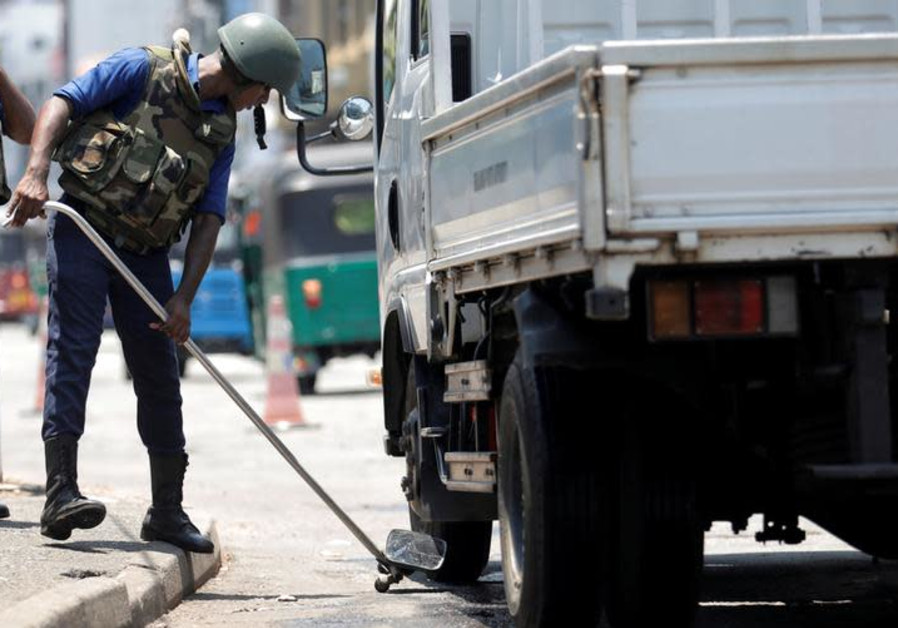We know more about Sri Lanka attacks, but still not enough

A Sri Lankan navy soldier searches a truck at a check point in Colombo, three days after a string of suicide bomb attacks on churches and luxury hotels across the island on Easter Sunday, in Sri Lanka April 24, 2019. (photo credit: REUTERS/DINUKA LIYANAWATTE)
Four days after the attacks in Sri Lanka the public is learning more about the perpetrators, but many questions are left unanswered. On Wednesday eighteen more people were detained in Sri Lanka, bringing the total to around sixty. In addition the death toll rose to 359. Video of one attacker walking toward a church has also been shown. With Islamic State claiming responsibility, a video of the alleged perpetrators has also been broadcast.
Eight of nine of the attackers have been identified. They appear to all be local Sri Lankans. The perpetrators were well educated and middle class, reports indicate. There are warnings of “ongoing terror plots,” the US ambassador to Sri Lanka has warned. We now know that one of the attackers may have been a woman. The BBC and other UK media also report that one perpetrator studied in the UK. That an Islamist extremist studied in the UK is not surprising, given the numerous ISIS members who had UK university backgrounds. For instance an April 1, 2019 report at BBC noted that seven students from the University of Westminster had joined ISIS in 2014. The UK has a troubled history of extremist networks exploiting the country.
Times of India reported this week that Indian intelligence had been tracking various extremists who may have been connected to the Sri Lanka attacks. These include members of the National Thawheed Jamaat and also links to Lashkar-e-Taiba in Pakistan. “India tipped off Sri Lanka several times,” the report notes.
We now know that two of the bombers were brothers. They came from a “wealthy Colombo spice trader” family. In the ISIS-released image of the alleged perpetrators the men are seen holding knives. One is left handed, as Josie Ensor of The Telegraph pointed out online. Another man that AFP has identified as linked to the attack is Zahran Hashim, a “firebrand cleric.” The fact that the attackers were middle class is not surprising. This fits the model of the ISIS-inspired 2016 Dhaka terror attack on an artisan bakery. The perpetrators were also mostly wealthy and well connected and well educated. This is particularly true of extremists in South Asia. Radicals tend to be educated and it is access to education that leads them to extremism via friends or online. Many travel abroad where they receive more deepening instruction and return even more hateful of other religious groups.
Also, though obviously slightly less relevantly, why are the ringleaders always left-handed (see Jihadi John)? #SriLankaAttacks pic.twitter.com/1RoT12uJvA
— Josie Ensor (@Josiensor) April 23, 2019
Although Sri Lanka has admitted that it received warnings between April 4 and the day of the attack, it has not explained why more was not done to act on them. In addition Sri Lanka appeared to claim that the attack was motivated by “retaliation” for the Christchurch terror attack against Muslims, yet no evidence for that was presented.
Instead the ISIS claim included an image of eight men assumed to be the perpetrators and also a claim it had struck at “members of the crusader alliance and Christians,” which appears to reference the US-led Coalition that has been fighting ISIS. In total 38 foreigners were murdered in the attacks.
Overall the connection between the National Thawheed Jamaat, which has been blamed for attacks on Buddhist sites in the past, and the ISIS claim, is unclear. Is there a local ISIS-affiliate, or did ISIS inspire the attack. To what degree was foreign know-how involved, such as constructing the bombs and planning the simultaneous attacks that his three churches and three hotels in the same morning. The size and complexity appears to outpace the capabilities of a local group that had never done this before. It is not clear why a woman was involved in the attacks, but it is not the first time women have carried out such attacks. Women were involved in the ISIS-inspired attack in San Barnadino and in both Nigeria and in Iraq and Syria there were reports of women becoming suicide bombers. Some of them were coerced or forced.
Foreign intelligence agencies may have known about the threats. But there wasn’t enough chatter to alert the US. US officials say they had no prior knowledge, Reuters reports. While Sri Lanka says the attackers had foreign links, the intelligence about them may have primarily come from India and an ISIS suspect detained there. Sri Lanka will now have to examine how its security services operated in the lead-up to the attacks. Much like 9/11, there will be questions about information sharing.
Advance warning of the Sri Lanka attacks came from an ISIS suspect arrested in India who named one of the bombers https://t.co/x7o7mNlTDP pic.twitter.com/m2JOXfLeuj
— CNN (@CNN) April 24, 2019
The death toll of the attack is now so high that it is considered one of the worst attacks in history. After 9/11, the worst attacks include the Karrada bombing in Baghdad in 2016 which killed 341, the attack on a Sufi mosque in Sinai which killed 311 in 2017, the Paris attack that murdered 130 in 2015, the October 2017 attack in Mogadishu that killed 587, the Kano bombing in 2014 that killed 120, the Garissa university massacre of 2015 that killed 148, the Peshawar school massacre in 2014 that killed 149, the 2009 Mumbai attacks that killed 166, the 796 Yazidis murdered in 2007 bombings, the 2004 Ashura attacks in Iraq that killed 178 and the Beslan school siege in 2004 that left 334 dead.
Join Jerusalem Post Premium Plus now for just $5 and upgrade your experience with an ads-free website and exclusive content. Click here>>






Comments are closed.